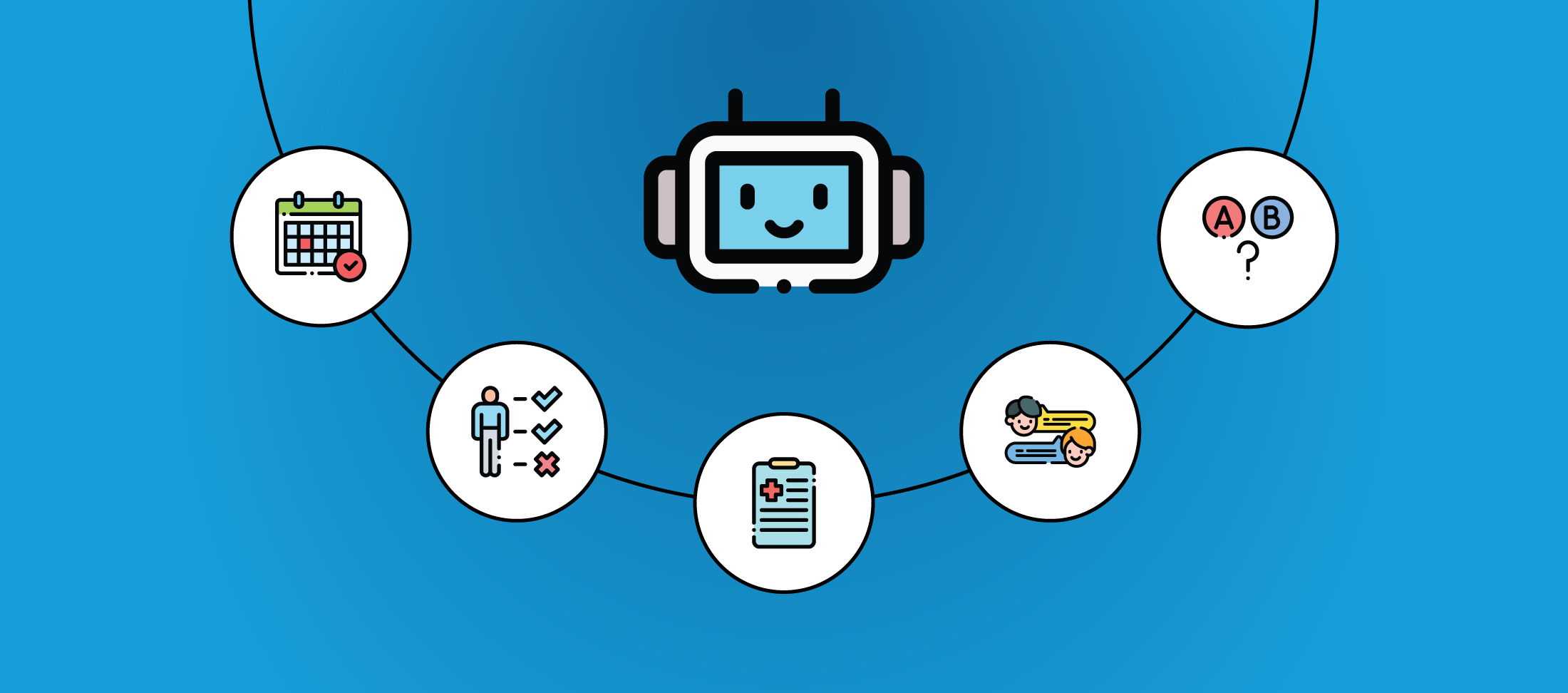Chatbots play an increasingly important role in healthcare. In addition to improving member and patient satisfaction, many chatbots gather data through conversations, providing rich, new sources of health data that can inform care at the individual and population level.
This post walks through nine different types of healthcare chatbots, the role chatbots play in healthcare, and recommendations to consider when using a chatbot to help serve your patients or members.
Types of Healthcare Chatbots and Their Value
Appointments
Scheduling (and rescheduling) healthcare appointments is a relatively simple process that has historically required at least one staff member for each appointment and been very time consuming. This is where appointment scheduling chatbots come into play. These chatbots make It easy for a patient to schedule an appointment on a website, inside a portal, through an app, or even via text message while including valuable information like reason for appointment, symptoms, etc.
In many cases, appointment scheduling chatbots need to be integrated with an EHR system to be most effective, which allows for automatic scheduling and re-scheduling with little to no human intervention. And when PHI is properly managed, these chatbots may also be able to deliver valuable information like lab results directly to the right patients.
Symptom Checker
At their best, chatbots provide more valuable and relevant information than a web search. They are able to do this because they are siloed; if a user is within a healthcare chatbot’s ecosystem, it can be assumed their questions are all healthcare related. When a user searches on the web, results often need to be broader to address a variety of intent.
In addition to an improved experience, as chat often feels more personal than search, symptom checker chatbots rely on a blend of healthcare experts to provide reliable data and Natural Language Understanding to analyze patient and member symptoms, return helpful information, and recommend care.
At their best, symptom checker chatbots align with appointment chatbots to help patients and members get necessary care with limited barriers.
Health Tracking
Many patients and members have ongoing health needs such as care prior to, day of, and following a procedure. These chatbots typically feature timely check-ins, medication / care reminders, and the ability to understand if a patient or member is reporting an adverse condition. These chatbots need to be able to log a record over time to be most effective and relevant.
Chatbots that help users with fitness or diet goals often fall into this category as well.
Chronic Condition Self-Management
Properly managing chronic conditions is an ongoing challenge for healthcare organizations and their consumers as chronic conditions require a blend of ongoing tracking and specific care as challenges related to the condition shift. Whether coordinating care, reminding people to take medication, providing valuable information or many other uses, these chatbots need to be able to both provide tailored information and react to changing individual needs.
Similar to Health Tracking chatbots, Chronic Condition Self-Management chatbots help users track and manage their condition on an ongoing, long-term basis. They typically require a more specific medical knowledge base than Health Tracking chatbots.
Engagement
Everything people do impacts their health. One challenge healthcare organizations face is getting people to engage with their health and healthcare. Afterall, there are so many other things that fill time and mindshare. Patient and member engagement chatbots create meaningful experiences and find valuable ways to connect with people and engage them in their health, whether by providing an important health reminder, uncovering some new healthcare information / status, getting a mental health update in real-time, or many other uses.
Engagement chatbots typically focus on consistent touchpoints and a long-term relationship with patients and members.
Digital Front Door
Chatbots are a key component of many successful digital front door applications. Digital front doors provide a virtual experience similar to a really great waiting room where a nurse collects key information to help optimize your visit and route care accordingly. Chatbots play a vital role here as they act as a combination receptionist, nurse, and source of information.
Digital Front Door chatbots must be personable and useful to consumers while gathering key information that helps healthcare organizations optimize care resources.
FAQs
While a symptom checker chatbot helps address patient and member questions about their health, FAQ chatbots help address questions about healthcare. The goal of FAQ chatbots is to provide a better experience and easier access to answers than scouring a healthcare organization’s website or portal in search of answers. Similarly, they reduce the burden on call centers by reducing inbound calls to find answers to common questions.
A smart FAQ chatbot is able to ask the user questions to refine and deliver the best answers.
Inbound vs Outbound Chatbots
Like any conversation, an interaction with a chatbot can be started by a consumer (inbound) or by the chatbot (outbound). In most cases, chatbot conversations are inbound as they trigger when a consumer visits and app or website and begins a chat. The challenge with inbound chatbots is they require a consumer to take an action (sometimes a few actions) before the conversation can begin. Outbound chatbots are less common as they require an existing, open channel to work. The best example of outbound chatbots is those that communicate through SMS or RCS, reaching consumers directly in their text message inbox.
mPulse offers a variety of solutions that feature outbound chatbots.
How Chatbots Need to Work Together
The overall goals of healthcare chatbots are to improve patient and member experience, optimize healthcare staff, help people stay healthier, gather valuable data, and make organizations more efficient. While specific chatbots can help address specific needs, a holistic approach is needed to accomplish all of these goals.
Learn how mPulse is combining omnichannel patient and member engagement with streaming health education to help solve many of healthcare’s biggest engagement challenges.




